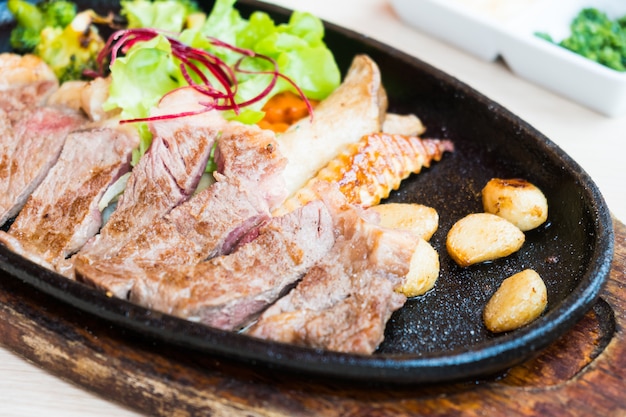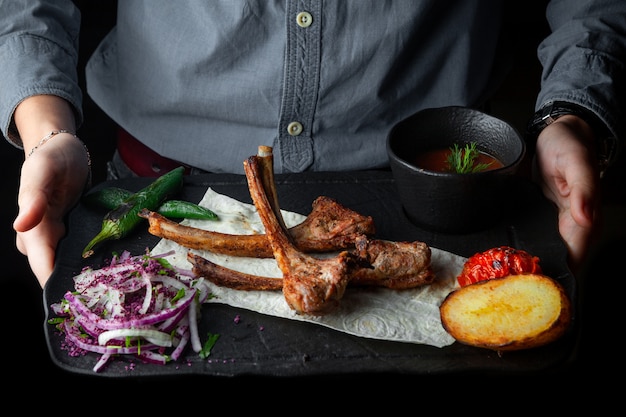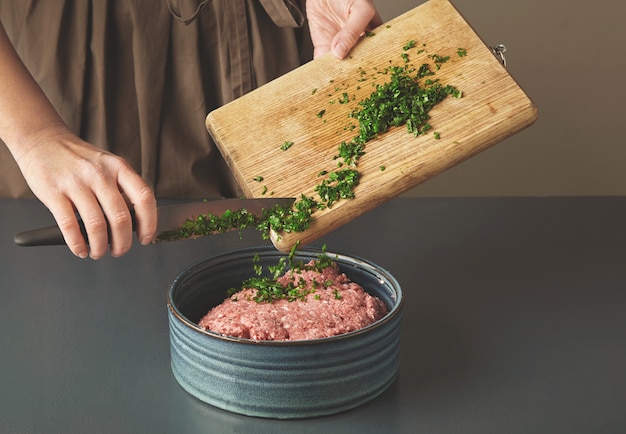(Part 1) Choosing Your Pork Chops

You can't expect to cook a phenomenal pork chop if you don't start with a good one. That means understanding the different cuts and making the right choice for your needs.
The Great Cut Debate: Bone-in or Boneless?
It all comes down to preference. Boneless chops are a breeze to handle, making them a great choice for quick weeknight meals. They're generally thinner, so they cook faster and are perfect for pan-frying or grilling. But if you're after a more robust flavour and a bit of rustic charm, bone-in chops are the way to go. The bone adds depth to the flavour and makes the chops look extra enticing on the plate. They also tend to be thicker, which is ideal for slow-cooking methods.
Thick vs. Thin: Finding the Right Thickness
Think about how you're going to cook your chops. For grilling or pan-frying, thick-cut chops are a fantastic choice. They'll hold up well on the grill and give you a nice, juicy interior. Thick-cut chops also allow for a more even sear, resulting in a beautiful golden crust. However, if you're short on time, thin-cut chops can be a good option. Just remember that they can dry out quickly if you overcook them. A quick pan-fry or a short grilling session is the best way to go with thin chops.
Quality Matters: What to Look For
The quality of your pork chops directly impacts the final result. Here's what to keep an eye out for:
- Color: Look for a pale pink color, free of any discoloration or bruising.
- Fat Marbling: A bit of fat marbling is actually a good thing! It adds flavor and helps to keep the meat moist. Look for chops with a good balance of fat and lean meat.
- Source: Buy your chops from a reputable butcher or a well-stocked supermarket. They're likely to have higher-quality meat.
(Part 2) Preparing Your Pork Chops

Once you've selected your perfect pork chops, it's time to prep them for the cooking stage. A few simple steps can make a world of difference.
Trimming for a Cleaner Bite
Let's face it, a little bit of fat adds flavour and moisture. But too much can make the chops greasy. Remove any excess fat, leaving a thin layer to ensure a good sear and juicy result. You can trim the fat with a sharp knife or use kitchen shears for a quicker approach.
Scoring for Enhanced Flavor and Tenderness
Scoring is a game-changer. It's a simple technique that involves making shallow cuts across the fat side of the chop, creating little slits. These cuts help the heat to penetrate more evenly, allowing the fat to render faster and resulting in a crispy crust. Scoring also creates more surface area for your seasonings to cling to, adding even more flavour. Use a sharp knife to make the cuts about ?? inch deep and spaced about 1 inch apart.
Seasoning for a Flavor Symphony
Now, it's time to unleash your creativity. Salt and pepper are always a safe bet, but don't be afraid to experiment with other seasonings. Here are a few ideas:
- Paprika: Adds a touch of sweetness and smokiness.
- Garlic Powder: Enhances the savoury notes.
- Smoked Paprika: Infuses a deep, smoky flavour.
- Herbs: Rosemary, thyme, sage, oregano—all work beautifully with pork.
- Spices: A pinch of cayenne pepper for a subtle kick or cumin for a warming flavour.
Brine for Juicier Chops
Brining is a technique that involves soaking the chops in a salt solution. It's a game-changer for juicy, tender pork chops. The salt draws moisture out of the meat and then draws it back in, resulting in a more tender and flavorful chop. A simple brine can be made with water, salt, sugar, and sometimes herbs or spices. You can soak the chops in the brine for 30 minutes to several hours. Just remember to pat them dry before cooking.
Marinating for Extra Flavor
Marinating is another great way to add flavour and moisture to your pork chops. A marinade is usually a blend of oil, acid (like lemon juice or vinegar), and seasonings. The acid helps to tenderize the meat, while the oil helps to keep it moist. You can marinate the chops for as little as 30 minutes or as long as overnight for maximum flavor.
(Part 3) Cooking Your Pork Chops

You've chosen your chops, prepped them to perfection—now it's time to cook!
Pan-Frying: A Quick and Easy Option
Pan-frying is perfect for a quick weeknight meal. It's simple, versatile, and delivers beautifully seared pork chops. Here's how to do it:
- Heat a heavy-bottomed pan over medium-high heat. A cast iron pan is ideal for this method, but any heavy pan will do.
- Add a tablespoon or two of oil, such as olive oil, vegetable oil, or even avocado oil. Let it shimmer before adding the chops.
- Place the chops in the pan, ensuring they don't crowd each other. This allows for even cooking.
- Cook for 3-4 minutes per side, or until they're nicely browned and crispy.
- Reduce the heat to low, cover the pan, and cook for another 5-7 minutes, or until the internal temperature reaches 145°F (63°C).
Grilling: The Perfect Summertime Treat
There's something magical about grilled pork chops. The smoky flavour, the char marks, the smell… it's pure summer bliss! Here's how to grill pork chops to perfection:
- Preheat your grill to medium-high heat. If you have a gas grill, preheat all the burners. If you have a charcoal grill, let the coals burn down until they're covered in white ash.
- Clean the grill grates and lightly oil them to prevent the chops from sticking.
- Place the chops on the grill, ensuring they're not too close to the flames. You want even cooking, not burning.
- Cook for 4-5 minutes per side, or until nicely charred and marked.
- If you have a gas grill, turn the heat down to low, cover the grill, and continue cooking for another 5-7 minutes, or until the internal temperature reaches 145°F (63°C).
- If you have a charcoal grill, use tongs to move the chops to a less direct heat zone to finish cooking.
Baking: A Gentle and Reliable Method
Baking is a simple and reliable method for cooking pork chops. It's especially good for thicker chops, as it allows them to cook evenly throughout.
- Preheat your oven to 375°F (190°C).
- Line a baking sheet with parchment paper. This prevents sticking and makes cleanup a breeze.
- Place the chops on the baking sheet.
- Bake for 20-25 minutes, or until the internal temperature reaches 145°F (63°C).
slow cooking: The Ultimate Tenderness
If you want melt-in-your-mouth tender pork chops, slow cooking is the way to go. It's a wonderfully hands-off method that yields incredibly juicy results.
- Place the chops in your slow cooker.
- Add a little liquid, such as broth, apple cider, or even water. This helps to keep the chops moist and flavorful.
- Cook on low for 6-8 hours, or until the meat is incredibly tender.
- You can add vegetables like onions, carrots, and potatoes during the last hour of cooking for a complete meal.
(Part 4) Temperature is Key: The Science of pork chop cooking
It's not just about how long you cook your pork chops, but also about reaching the right internal temperature. This ensures food safety and delicious results.
Food Safety: Why Temperature Matters
Pork contains bacteria that can cause illness. Cooking the pork to an internal temperature of 145°F (63°C) ensures that any harmful bacteria are destroyed. This is crucial for food safety and prevents any unpleasant consequences.
Tenderness and Juiciness: The Importance of Doneness
Reaching the right temperature guarantees tender and juicy pork chops. overcooked pork chops can become dry and tough, losing their delicious flavour.
The meat thermometer: Your Essential Tool
Don't rely on guesswork. Invest in a meat thermometer—it's the most reliable way to ensure your pork chops are cooked to perfection. Insert the thermometer into the thickest part of the chop, avoiding bone. When it reaches 145°F (63°C), you're good to go!
(Part 5) Resting: A Vital Step to Juicy Perfection
Just like a good bottle of wine, pork chops need time to relax after cooking. Resting allows the juices to redistribute throughout the meat, resulting in a more tender and flavourful chop.
Why Resting is Essential
During cooking, the juices in the meat are pushed to the surface. When you cut into the meat immediately after cooking, those juices escape, leaving you with a dry chop. Resting gives the juices time to be reabsorbed, ensuring a moist and flavourful bite.
How Long to Rest Your Pork Chops
A good rule of thumb is to rest your pork chops for 5-10 minutes. Cover them loosely with foil to prevent them from drying out.
(Part 6) Serving Your Pork Chops: A Culinary Showcase
You've cooked the perfect chops. Now, it's time to showcase them in all their glory!
Accompaniments: The Perfect Pairing
Pork chops are incredibly versatile, so you can pair them with a wide range of sides. Here are a few ideas to inspire your culinary creativity:
- mashed potatoes: A classic comfort food pairing.
- Roasted Vegetables: A healthy and flavourful option. Try asparagus, broccoli, Brussels sprouts, or root vegetables.
- Green Salad: A refreshing counterpoint to the rich flavors of the pork chop.
- Couscous or Quinoa: Light and fluffy alternatives to rice.
- Apple Sauce: A sweet and tart accompaniment that complements the flavour of pork.
- Mushroom Sauce: A rich and savory sauce that elevates the flavour of the chops.
Presentation Matters: A Feast for the Eyes
Even the simplest meal can be elevated with a beautiful presentation. Arrange your pork chops on a platter, place a dollop of mashed potatoes alongside, and garnish with fresh herbs for a visually appealing and delicious dish.
(Part 7) Pork Chop Variations: Beyond the Basics
Ready to take your pork chop game to the next level? Here are some delicious variations to try:
Breaded Pork Chops: A Crispy Delight
For a satisfyingly crispy and flavourful meal, bread your chops in seasoned breadcrumbs or panko. You can even add a little Parmesan cheese for extra flavour. Pan-fry or bake until golden brown and crispy.
Lemon Herb Pork Chops: A Light and Refreshing Option
Marinate your chops in a mixture of lemon juice, garlic, and herbs like rosemary and thyme. This is a simple and refreshing choice, perfect for a light summer dinner. Pan-fry or grill until cooked through.
Pork Chops with Apples and Sage: A Fall-Inspired Treat
For a warm and comforting meal, try pork chops with apples and sage. Pan-fry the chops, then add sliced apples and fresh sage. Continue cooking until the apples are tender and the pork is cooked through.
Pork Chops with Pineapple Salsa: A Sweet and Spicy Twist
Top your cooked pork chops with a vibrant pineapple salsa made with pineapple, red onion, jalapeno peppers, and cilantro. It's a combination of sweet, spicy, and tangy flavours that will make your taste buds sing.
(Part 8) FAQs: Answering Your Pork Chop Queries
Let's address some common questions about pork chops.
1. Can I Freeze Pork Chops?
Yes, you can freeze pork chops for future use. Wrap them tightly in plastic wrap or aluminum foil and place them in a freezer-safe bag. They'll stay fresh for 3-4 months in the freezer. When ready to use, defrost overnight in the refrigerator or by placing them in a bowl of cold water.
2. What If My Pork Chops Are Dry?
Don't despair if your pork chops are a little dry. There are ways to salvage the situation. Try these tips:
- Add a little sauce or gravy to the chops to add moisture.
- Make a pork chop sandwich with a slice of cheese and a toasted bun. The cheese will melt and add moisture, while the bun will soak up any excess juices.
- Chop the dry pork chops into small pieces and use them in a stir-fry or soup.
3. How Long Does Pork Chop Take to Cook?
The cooking time depends on the thickness of the chops and the cooking method.
- Thin chops will cook faster than thick chops.
- Pan-frying usually takes 10-15 minutes, while grilling or baking takes 20-30 minutes.
- Slow cooking can take up to 8 hours.
4. What are Some Good Wines to Pair with Pork Chops?
Pork chops are very versatile, and they pair well with a variety of wines.
- For lighter dishes, try a crisp Sauvignon Blanc or a fruity Pinot Grigio.
- For richer flavors, go for a full-bodied Cabernet Sauvignon or a robust Merlot.
- A light-bodied red like Pinot Noir also pairs well with pork.
- If you're having a sweeter pork chop dish, a Riesling or Gewürztraminer can be a nice pairing.
5. How Can I Tell If My Pork Chops are Done?
The best way to check is to use a meat thermometer. The internal temperature should reach 145°F (63°C). You can also check the chops by cutting into the thickest part. The meat should be no longer pink and the juices should run clear.
(Part 9) Conclusion: Embark on Your Pork Chop Journey
You've got the knowledge, the techniques, and the inspiration. Now, it's time to put your skills to the test and create some incredible pork chops! Remember, it's all about choosing the right cut, prepping them well, and cooking them to the perfect temperature. So, next time you're craving a satisfying and delicious meal, give pork chops a try. They're truly a culinary masterpiece waiting to be discovered!
Everyone is watching

How to Cook Frozen Lobster Tails Perfectly: A Step-by-Step Guide
RecipesLobster. Just the word conjures up images of lavish meals, special occasions, and a taste of luxury. But let's...

Pigs in a Blanket Cooking Time: How Long to Bake for Perfect Results
RecipesAh, pigs in a blanket. Just the name conjures up images of those delightful little parcels of crispy pastry en...

Pork Fillet Cooking Time: How Long to Cook It Perfectly
RecipesPork fillet, or tenderloin as it's sometimes called, is a real favourite in our house. It's so versatile, and...

The Ultimate Guide to Cooking Delicious Frankfurters
RecipesLet's face it, we all love a good frankfurter. It's a classic, simple, and always satisfying. But let's be rea...

Wolf Meat Recipes: A Guide to Cooking Wild Game
RecipesLet's be honest, you don't see wolf meat at your local butcher shop every day. It's a bit of a wild card, but ...
